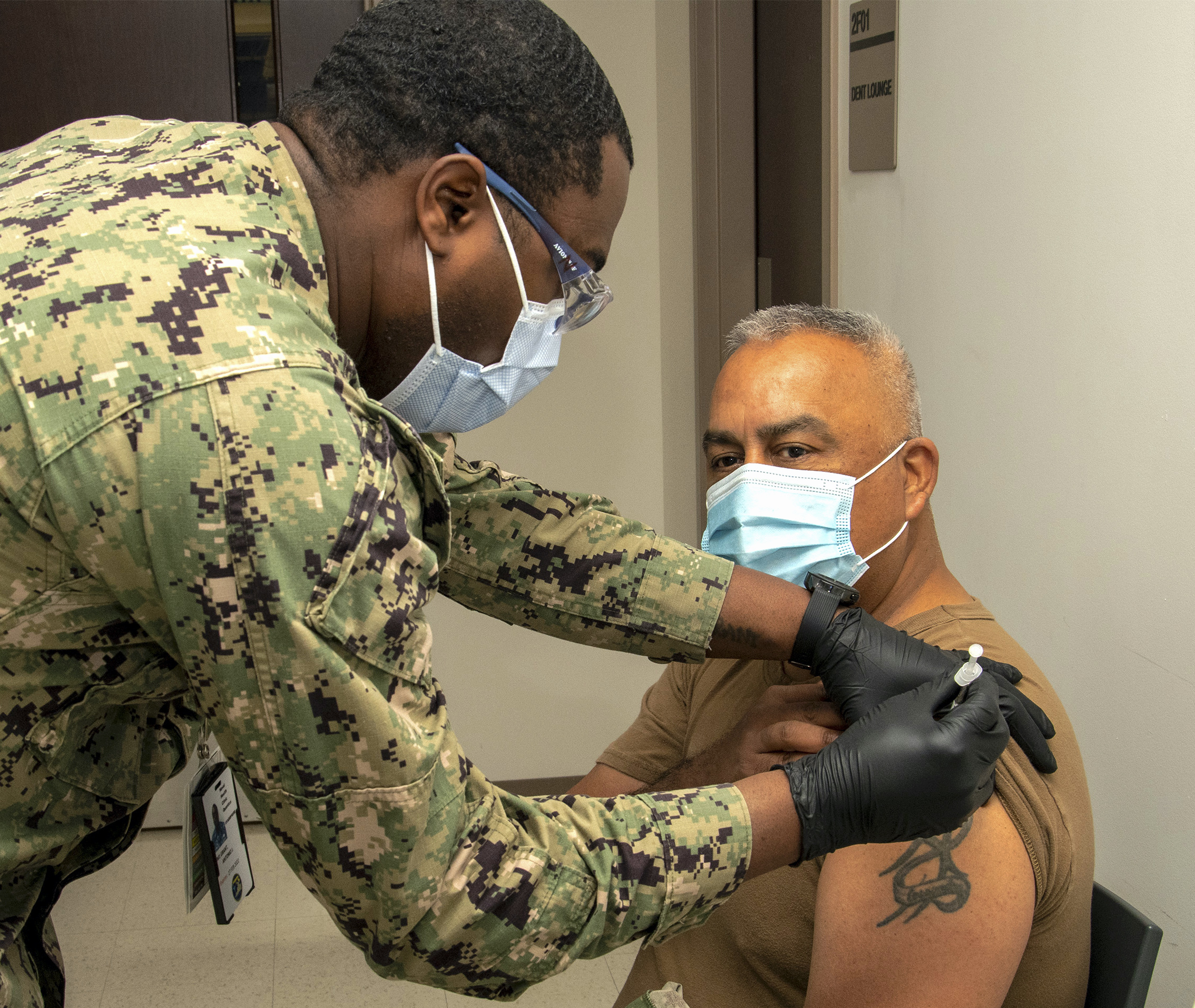
Nearly a quarter of the Navy’s active-duty sailors have received either one or both doses of a COVID-19 vaccine, a service official told reporters Friday.
Rear Adm. Karl Thomas, the assistant deputy chief of naval operations for operations, plans, and strategy (N3/N5B), said approximately 35,000 sailors have had their first of two doses of the vaccine, while 45,000 have received both shots.
“So that equates to about 10 percent of our military members have had their first vaccine, with another 13 percent that are fully immunized. And so obviously we’re also providing our vaccine to the civilians that work for us and to beneficiaries within [military treatment facilities], and also to other service members,” Thomas told reporters during a telephone roundtable.
The actual number of vaccinations the Navy has administered is higher, since some Army and Air Force personnel have also received their COVID shots at Navy medical facilities.
While some active-duty sailors have turned down the vaccinations, Thomas said the Navy is performing surveys to better ascertain sailors’ concerns and is also implementing education initiatives to provide accurate information to sailors about why they should opt to get the vaccine.
“So we on a unit basis have an idea of what type of people, numbers of people that have declined it. We’ve actually seen very high levels of acceptance on units that are preparing to deploy. I think the sailors understand the benefits of getting immunized and what that does to them and their shipmates,” Thomas said.
“As far as a holistic number, because we are trying to get people to come back and take it even if they initially defer the vaccine – we actually use the word defer because we want them to come back and get it when they realize and can educate themselves and make a choice – we don’t have an overall number at this point,” he continued.
USNI News recently reported that one-third of service members who have been presented the chance to receive COVID-19 immunizations have declined. The Pentagon cannot require service members to get the shot because the Food and Drug Administration approved both the Moderna and Pfizer vaccines under its emergency use authorization.
Referring to the number of service members who have declined the vaccine, Pentagon spokesman John Kirby told reporters in a Friday statement that the Defense Department doesn’t “track that data centrally.”
“Our data collection is limited right now, because department reporting systems for medical readiness and electronic health records capture data on patients who actually receive healthcare … not for those who don’t,” Kirby said.
“We do not record those who do not receive vaccines. This is true for those who have not yet been offered vaccines and for those who have been eligible but have chosen not to receive the vaccine, or have not decided yet,” he continued. “I would also point out that some personnel cannot be vaccinated for medical reasons.”
Thomas said the goal is to have 75 to 80 percent of sailors on a ship vaccinated.
“My vision is – as the guy that’s trying to provide more and more normalcy to the folks that are operating at sea – is I would love to see us be able to get the number down to 75 or 80 percent immunization levels as our next effort that we’re really going after,” Thomas said.
“We think that that’s a very achievable number on ships to be able to get to that level of immunization,” he continued. “And then you know, the modeling that we’re doing is really looking at what does that do to the other 25 percent or 20 percent of the crew that maybe doesn’t have the shot and what is the risk and what type of procedures will we need to put in place to still protect those individuals.”
The Navy recently released its Standardized Operational Guidance 4.0, which is the fourth iteration of the guidance and the first to include how the service should account for the new COVID-19 vaccines when implementing public health measures.
Part of the guidance follows directions from the Centers for Disease Control and Prevention. For example, sailors who have been vaccinated and are exposed to COVID-19 do not have to quarantine anymore, as long as they meet specific guidelines.
“If a sailor’s immunized, they no longer have to quarantine, provided they received the shots in the last 90 days and it’s been two weeks since their last vaccine, provided that they’re asymptomatic,” Thomas said. “Again, yet another example of working to get time back to sailors by accepting a very small risk.”
While the Navy has been implementing bubble methods and restriction-of-movement (ROM) sequesters to ensure sailors preparing to deploy do not contract COVID-19, now sailors who have been fully vaccinated can remain at their own homes, instead of a hotel room or other housing, for the two weeks leading up to deployment.
“For someone that’s immunized, we now afford the opportunity for immunized individuals to do home to work vice sitting in isolation in ROM,” Thomas said.
Commanders of units with members that do not have the vaccine and are not operational can decide whether they want to use the CDC’s guidance for a 10-day quarantine period, or a seven-day period if an individual gets a COVID-19 test after five days. Units that are operational will still need to adhere to a 14-day quarantine period “for added mission assurance” because of how easily the virus can transmit on a ship, Thomas said.
If all members of a crew have received the vaccine, some of the public health procedures can be lifted.
“These 100-percent crews no longer have to ROM sequester and can relax health protection measures once at sea after a short time based on the size of their crew, which we think is a huge incentive,” Thomas said.
Like concerns among the general population, the Navy is also worried about whether individuals who have been vaccinated can still spread the virus.
“That’s really the $64,000 question right now is transmissibility after immunization,” Navy Surgeon General Rear Adm. Bruce Gillingham told reporters during the call.
Billingham cited the vaccine’s ability to decrease the severity of a COVID-19 infection as a positive development.
“The other good news that we’re seeing thus far, just in the population is that those who are immunized, well, if you have a highly vaccinated crew, if there are cases of COVID that occur, they tend to be of lower amplitude, less severe. And so we’re seeing that as reassuring as well,” he said.





